
Atlas F1 Technical Writer
The Italian Grand Prix at Monza always presents a challenge to the Formula One teams due to its long straights and the massive forces applied to their brakes. This year's race was no different. Craig Scarborough reviews the teams and their methods to cope with those challenges
All the teams arrived at the race after a week's testing at the circuit, so each had a lot of knowledge and had established a low downforce set up and allowed the tyre manufacturers to optimise their tyre choices. Friday was much more about refining set ups and responding to small temperature and wind changes rather than finding the baseline.
The low drag set up was used by all the teams, slimmed down front wings and two or at most triple plane rear wings, winglets on top of sidepods were replaced by lower drag flip-ups for some teams and the improved flow to the sidepods allowed many teams to run without extra chimneys or outlets. Two teams brought wings developed specifically for this race, Williams and McLaren used anhedral wings that forsake the extra downforce generated by a dipped centre section and actually raised the middle part of the wing improving flow over and under the car.
Brake ducts were similar to the large format ducts seen in Canada, but no new approaches seem to have appeared since then; refinements in materials account for the improvements in braking performance.
HANS
Sauber kept up their promise to run all weekend with the HANS head and neck safety device. This collar tethers the drivers head to the car to prevent neck injury in major accidents. Many drivers are critical of the devices claiming prototypes tried in testing hampered their movement in the car. As each car and each driver are of a different shape these devices need to be individually made to the driver/car combination. Patrick Head commented Juan Pablo Montoya's neck was shorter than Ralf Schumacher's which lead to trouble getting the device to fit in the limited clearance created between Juan's helmet and shoulder straps. Helmet manufacturers will need to modify their shells in order to allow the drivers to race with the HANS device that will be mandatory for 2003.
BMW's 19,000RPM
During the winter break before the 2002 season technical observers pondered what the aims for the engine manufacturers would be for 2002. The target of 900 bhp and 19,000 rpm were quoted as the magical figures for the leading teams to hit. All this year the top engines have run in the high 18,000 rpm range and output figures were suggested as high as 89 0bhp. With the output figures closely guarded by the manufacturers, the FIA decision to display actual RPM figures on the digital feed, the manufacturers can no longer hide these stats.
The one engine per weekend rule for 2004 is bound to affect the output and rpm figures so this year and the next one may see the fastest and most powerful 3.0 litre V10 engines for some time.
Progress for BMW since it returned to F1 in 2000 has been startling, the stated rpm ceiling for their first race V10 was only 17,000 rpm, a staggering 12% increase in revolutions in less than three years.
BMW neatly summed up the stats for an engine running this speed:
19,000 revolutions a minute means: 9,500 ignitions a minute per cylinder, 158 ignitions per second for each cylinder, one ignition every six thousandths of a second.
Tyres
Tyres were of slightly less importance here at Monza, but they still had an impact on the cars handling in and out of the chicanes. At Monza tyres need a stiff construction to provide the car with stability under braking as there is less downforce to keep the car on the road, also a soft compound to provide grip for traction out of the corners in order to achieve that crucial top speed as soon as possible down the proceeding straight.
In the tyre war Michelin could be considered to be the winner in Italy, although Ferrari dominated the race and Friday sessions.
It was the Michelin tyre that provided all its teams with the crucial grip and stability, with only Renault left looking for pace on the French tyres. Bridgestone's customer teams were finding the tyres compound and construction to be too hard, reducing the cars' poise under braking and necessitating more downforce to be run in order to balance the car. In the cooler qualifying session the stiffer tyre proved too hard to warm up and the teams were obliged to complete two warm up laps to get the tyre to temperature and pressure, thus reducing the number of "runs" each driver could complete, forcing them to do three four-lap runs rather than the more usual four three-lap runs.
With the traffic and the accuracy required for the chicanes this compromised the Bridgestone teams' chances of getting a clear run on hot tyres. The warmer race provided more pace for the Bridgestone teams but Michelin were at least their equal.
Team by Team
Ferrari
The Ferrari had a low downforce wing package for this race using familiar wing sections seen in previous races and returned the front wing endplates to the rectangular format seen early in the year. What was different at Ferrari this weekend was the absence of Ross Brawn for parts of the weekend, as he had injured his back while cycling. Substituting in his role was Luca Baldisseri, who is being tipped as Ross' replacement when he departs form Ferrari after 2004. Luca usually is Michael's race engineer, so ex-Arrows engineer Chris Dyer filled this role.
Saturday's session brought more woe for Rubens: after only four laps his engine expired in a cloud of smoke and Rubens had to leave the car by the edge of the track, thus bringing out the red flags in order to move the car to a safer location. Michael had a cleaner run with only a spin in the chicane to complicate his session.
With a new qualifying specification engine the Ferrari drivers expected to do well in the Saturday timed session, but were each beaten by a Williams. The red flag interruption caused by Sato/Raikkonen hindered their running, as did the need to complete two "out" laps to get the best out of their tyres.
For the race their compromised grid positions lead the team to split their strategies and allow Rubens to try the two stop race he attempted last year. This year Rubens' two stops on laps 19 and 37 for a total of 16.8 seconds saw him leave the pit exit just ahead of his teammate who stopped just once on lap 28 for 10.8 seconds; Rubens was then able to pull clear of Michael. At the start Rubens' lighter fuel load allowed him to pass Michael off the grid and then Juan and Ralf en route to the win. Michael had a clear run once the Williams eliminated themselves. The two drivers later dropped their pace, firstly Michael, slowing to let the Coulthard/Villeneuve battle past and then Rubens slowed to allow several drivers to unlap themselves and for Michael to close in, in order to provide a formation finish at the team's home race.
Williams
Running the anhedral wing seen in testing allied to endplates without a cut-out on their top edge to reduce drag, both drivers were happy with the car and tyres, and were able to complete a normal Friday session without drama.
Qualifying saw the two Williams drivers being able to lap faster and faster, with the Michelin tyres aided by a new specification BMW engine that clocked 19,050 rpm in the session. As with all the other drivers they lost out with the red flag towards the end of the session and Ralf had to use worn tyres for his final run and hence wasn't able to improve on his fourth position. Juan was able to gain pole and a record already held by Williams for 17 years, the fastest single lap with an average speed of 161.484 mph just over half a mile per hour faster than Keke Rosberg's previous record from Silverstone.
Ralf initially drove his race car out of the pitlane before the race, but a fuel pressure problem was detected and he switched to the T-Car for the race. Ralf had a better start than Juan who nearly stalled. He then ran across the kerbs to keep ahead and was ordered by the FIA to let Juan back past. As Ralf lifted off on the straight to comply with the order there was failure in the engine's pneumatic valve system and it exploded spectacularly.
Juan Pablo ran new tyres at the start but as he had both Ferraris get past him in the opening laps, he struggled on the brakes for most of his opening stint. He pitted once for 11.4s on lap 30. Then three laps later he ran wide over the chicane and lost some bodywork from the barge boards and then at the next chicane he understeered over the rumble strips and damaged his front suspension, then pitted for the team to inspect the reason for the cars' deranged state, and had to retire.
McLaren
Kimi's qualifying ended prematurely and spoiled the closing minutes of the session for the rest of the field. "My incident with Sato is one of those things which happen in racing. He was on his fifth consecutive lap, and my team was under the impression that he would be coming into the pits, which is what you would expect during qualifying, and advised me accordingly. When I couldn't see him in my mirrors, I believed he had slowed down and went for the line into the corner. The team tried to get the spare car, which was set up for David, ready for my last run, but in the short amount of time available it was impossible." The race stewards deemed Kimi responsible for the accident and docked his fastest time demoting him to sixth on the grid. David found the balance of the car "elusive" in qualifying and ended up seventh.
David pitted on lap 37 for 8.2s. On fresher tyres, so late in the race, he was able to catch and pass Villeneuve and then with more trouble pass Fisichella, posting the fastest straight-line speed of 363kmh with the help of a tow from the Jordan. He was unable to catch Panis and ended up just out of the points in 7th.
Renault
Friday was spent developing the set up honed in testing and the team were confident. Qualifying found the team struggling to post fast times, Trulli's fastest lap was aided by slipstreaming teammate Button on some of the straights. Button lost most of the morning session following a spin and he posted only the seventeenth fastest time.
Faced with the poor grid slots the team said their race strategy would be "conservative".
This plan was revised after Jarno failed to leave the dummy grid as the car wouldn't engage first gear: he almost ran over other teams' personnel as he finally left the dummy grid and he started from the back of the grid. Jarno made great progress through race, aided by a modified pit strategy which saw him pit extra on lap 23 and then told on the radio to "push-push-push". His team mate Button came in a lap later and managed to get ahead of Jarno in the sequence.
The change to the early pit stops confused the other teams, as the cars were only stationery just over 9 seconds. This wouldn't have been enough to run to the end of the race were the tanks empty at the stop, and indeed the tanks were not empty but this was the earliest point a stop could be made to "top up" the half empty tanks for the full race distance.
Jenson let the faster Jarno past in order to chase down Irvine: the Irishman was never caught but Renault were pleased that reliability held together for a double points finish in fourth and fifth.
Sauber
On Friday Felipe Massa was happy with the car until he tried a different direction with the set up and lost a lot of grip in the process, while Nick was unhappy with the car all day and complained of low grip and excessive bottoming which could not be explained. On Saturday Nick had cured the bottoming problems and improved the grip from the car, meanwhile Felipe had returned the car to the set up used earlier on Friday and battled with understeer on each of his runs. Tyres were blamed as the reason for the lack of pace and both drivers were expecting better tyre performance for the race. Nick chose to run a two-stop strategy and was able to pass a few cars initially but then made no further progress to finish tenth.
Felipe had a more fighting race and, while chasing a fast but untidy Pedro de la Rosa in the Jaguar, he was able to pass on the straight, but then misjudged where he was on the road and was struck by the Spaniard. He carried on but damage to the rear suspension and tyre forced him to pull over a lap later.
Jordan
The Friday sessions were only upset by an electrical misfire for Sato, otherwise both drivers were happy with the cars' balance, but struggled to get the tyres up to temperature quickly enough on track. Similar tyre troubles in qualifying kept Fisichella back in twelfth, while Sato made two errors on his first runs and was hit by Raikkonen, leaving him back in eighteenth with a damaged car to be repaired.
Deciding to run a long first stint, Giancarlo's start was even worse than expected with the weight of fuel when his launch control played up and left him several positions lower down at the end of the first lap. He pushed throughout the race but could only recover to eighth. Takuma found the car difficult to drive and although it later improved he was chasing Yoong's Minardi for some time and was failing to make an impression or subsequent progress after Yoong pulled into the pits.
Jaguar
Jaguar didn't have any special new parts for the race instead retaining the revised front uprights and suspension from Spa. But the weekend suited the Michelins and with the car unloaded of downforce the power from the underrated Cosworth engine was able to push the Jaguars along at a pace not seen all year.
This placing was lost at the start when Kimi made a better start and was able to pull away. Eddie made his one stop on lap 28, stopping for 12s, and was told not to use the launch control for fear of inviting problems, so instead he left the pits with spinning tyres slower but more reliable, and ran clear of other drivers until he eased his pace later in the race allowing Trulli's Renault to close up. He finished in third, equalling last year's Monaco result, which is surprising given the totally different requirements of Monza and Monaco.
Pedro was having a great race but started to get untidy in the chicanes under pressure from Massa; he straight lined one chicane on lap 16 and Massa was able to slipstream past him, but Massa didn't leave room for Pedro to brake for the corner and his front suspension hit Massa's rear, wrecking his suspension and front wing, forcing him into retirement. Pedro still has no points this year.
BAR
Jacques had a gearbox related hydraulic problem hampering him on Friday and both he and Olivier had a productive day but the times were well down the midfield. Once more a new specification Honda engine was available for the timed session, but still the low downforce set up on the Bridgestone's was failing to provide enough grip. Jacques posted an excellent ninth while Olivier struggled more in traffic.
In the race Jacques' one stop strategy with more wing failed to allow him to overtake or protect himself from overtaking. Whereas Olivier chose a riskier two stop strategy and was able to make the most of the light car at the start jumping up the grid and then continue to pass throughout the race. It all paid off when BAR got their second batch of points as Olivier came home sixth.
Toyota
Friday proved to be night and day between the two drivers, Mika was happy with the car on a low downforce set up and being able to use the engine's prodigious power output. Whereas Allan found it totally unbalanced and then suffered gearbox problems necessitating a rear end change, with the two problems effectively wasting the two sessions for him.
Saturday found the car improved on full tanks but the balance was lost when the cars were running qualifying levels of fuel; eventually both drivers were satisfied with tenth and thirteenth, even if they felt they could have got a little more out of the car.
The morning warm up further improved the car on heavy fuel and the cars' weak performance over the kerbs was "as good as we're going to get it," according to McNish. Allan made an excellent start, getting up to 7th from 13th and then started to struggle through chicanes. He did however post the fastest unassisted speed trap time at 361, only beaten by Coulthard who got a slipstream from Fisichella. But Allan's handling of his car was becoming unpredictable and he feared a slow puncture or suspension failure. He pitted on lap 12 and was given new tyres; while he was stationary for 25 seconds he gesticulated furiously about the rear suspension, the team looked it over and sent him out again, he then re-pitted after one lap to retire with front suspension problem.
Mika had a strong race running well in the points despite blistering tyres until his 10-second pitstop on lap 31. As he left the pits, he was more conscious of his mirrors than the white pit exit line, which his front wheel touched. He was given a pitlane penalty effectively ending his competitive race. He eventually ended the race classified as 11th beating only Sato and Yoong.
Minardi
On Friday, Yoong made a change to the car in the afternoon, which made it very nervous and had a spin as a result. Webber made progress on the balance of the chassis and both drivers finished the session in the last two places. Qualifying found the drivers finding yet more speed from the cars' set up and both lost out with the red flag at the end of the session, again finishing P19 and 20.
Webber scored a rare retirement with engine ECU failure, forcing him to pull off the track with no power on lap 21. Yoong was able to keep ahead of the Jordan of Sato for his opening stint, but then had a long pit stop with an electronic problem causing the engine to die and not restart. The car was pushed into the garage for remedial work to be carried out and was able to return to the race to finish last and 6 laps down.
Monza is said to be all about maximum speed, or vMax (maximum velocity) as the teams' telemetry displays it. While in fact the goal is not outright speed but the shortest amount of time spent on any given straight, which is a factor of top speed, getting up to the maximum speed as quickly as possible, and keeping up that speed for as long as possible before the next braking zone. Engine power and low drag enable the highest speed, and also entry speed onto the straight counts for a lot. This is why some teams with high top speeds were struggling, as they had more speed to gather after low corner exit speed. So tyres, traction and brakes are all crucial to allow the driver to maximise the use of vMax, the top speed.
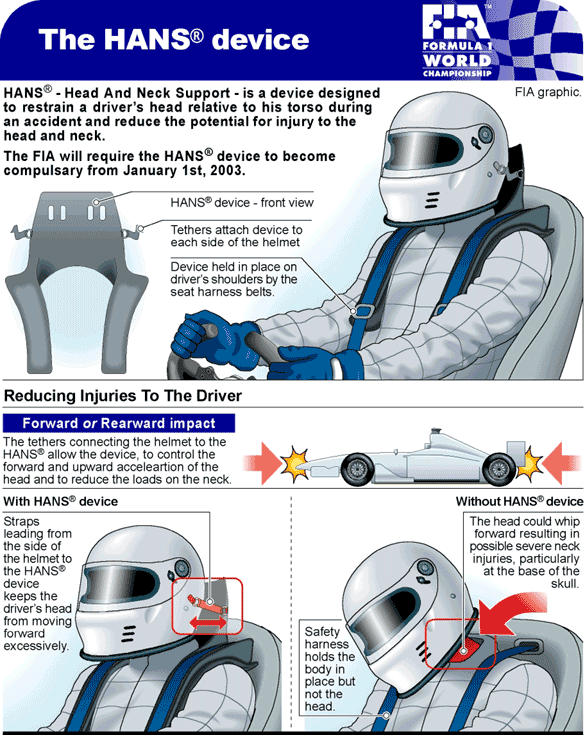
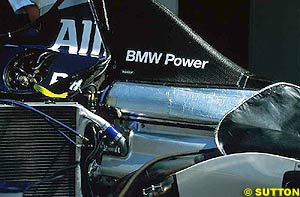 The BMW engine in the Williams for qualifying was a developmental unit for future races and for the first time reached over 19,000 rpm in a race weekend, with BMW backing this up with an admission of the rev ceiling. Rumours are now suggesting the development of the engines for 2003 are already well over 19,000 rpm and will start the new season from that figure. While rpm is not the sole factor in an engine's output, it does suggest that the teams are finding gains in a formula that greatly restricts their choice of materials for the engine.
The BMW engine in the Williams for qualifying was a developmental unit for future races and for the first time reached over 19,000 rpm in a race weekend, with BMW backing this up with an admission of the rev ceiling. Rumours are now suggesting the development of the engines for 2003 are already well over 19,000 rpm and will start the new season from that figure. While rpm is not the sole factor in an engine's output, it does suggest that the teams are finding gains in a formula that greatly restricts their choice of materials for the engine.
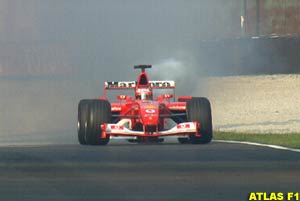 Friday found Rubens on track with failing hydraulics for his brakes: he returned to the pits for the system to be repaired but it took one more installation lap to cure the problems, which caused Rubens to lose some track time. Michael as usual had no such problems.
Friday found Rubens on track with failing hydraulics for his brakes: he returned to the pits for the system to be repaired but it took one more installation lap to cure the problems, which caused Rubens to lose some track time. Michael as usual had no such problems.
 Also running the anhedral wing from testing, McLaren were not at ease on this circuit. David struggled on Friday, often over shooting the chicanes. He also went off at the start of the second Friday session and beached the car in the gravel. "At the start of the second session the rear of the car locked up at the second Lesmo, and I'm not sure whether it was a problem with the brakes or the gearbox". Meanwhile Kimi described Friday's sessions as "uneventful" as he worked on set up.
Also running the anhedral wing from testing, McLaren were not at ease on this circuit. David struggled on Friday, often over shooting the chicanes. He also went off at the start of the second Friday session and beached the car in the gravel. "At the start of the second session the rear of the car locked up at the second Lesmo, and I'm not sure whether it was a problem with the brakes or the gearbox". Meanwhile Kimi described Friday's sessions as "uneventful" as he worked on set up.
 Both cars were planning to run a long first stint in the race, so the cars' tanks were topped up on the grid to ensure they were full, David started on new tyres and followed his teammate into the first corners; unfortunately he hit Kimi and ripped off his own front wing, therefore needing to pit for a new nose and returning to the race dead last. Kimi was able to beat Eddie Irvine at the start to regain his lost qualifying position, he then was able to pull away from Eddie until a major engine failure on the run down to Parabolica on lap 30 ended his race.
Both cars were planning to run a long first stint in the race, so the cars' tanks were topped up on the grid to ensure they were full, David started on new tyres and followed his teammate into the first corners; unfortunately he hit Kimi and ripped off his own front wing, therefore needing to pit for a new nose and returning to the race dead last. Kimi was able to beat Eddie Irvine at the start to regain his lost qualifying position, he then was able to pull away from Eddie until a major engine failure on the run down to Parabolica on lap 30 ended his race.
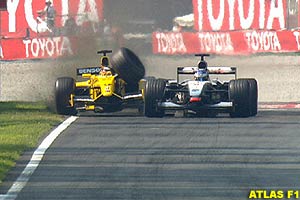 Jordan had a cut down front wing for Monza, the usual one piece full width secondary flap was split into two, by removing the centre section. The fin within the front suspension was once again present, but not the faired pushrod cover.
Jordan had a cut down front wing for Monza, the usual one piece full width secondary flap was split into two, by removing the centre section. The fin within the front suspension was once again present, but not the faired pushrod cover.
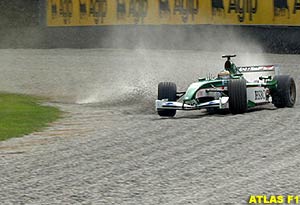 Pedro provided one of the TV moments of the year when he went off wide into the Parabolica gravel, in a shower of stones and opposite lock he power-steered the car out of the gravel at high speed and avoided the barrier, later commenting the team's radio "phew, that was close." Qualifying brought out a new spec engine and this powered the drivers to a season's best of sixth and eighth. Eddie was promoted to fifth on the grid when Raikkonen was penalised for his incident with Sato.
Pedro provided one of the TV moments of the year when he went off wide into the Parabolica gravel, in a shower of stones and opposite lock he power-steered the car out of the gravel at high speed and avoided the barrier, later commenting the team's radio "phew, that was close." Qualifying brought out a new spec engine and this powered the drivers to a season's best of sixth and eighth. Eddie was promoted to fifth on the grid when Raikkonen was penalised for his incident with Sato.
Please Contact Us for permission to republish this or any other material from Atlas F1.
|
Volume 8, Issue 38
Atlas F1 Exclusive
Interview with Richard Cregan
Articles
On the Right Track
Monza Madness
Ann Bradsaw: View from the Paddock
Italian GP Review
Italian GP Review
Italian GP - Technical Review
31 Years Ago...
Open Letter to Fujio Cho
Stats Center
Qualifying Differentials
SuperStats
Charts Center
Columns
Season Strokes
Elsewhere in Racing
The Grapevine
> Homepage |